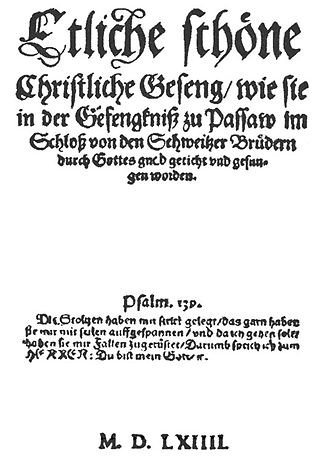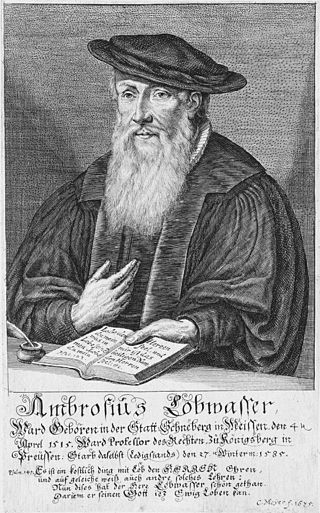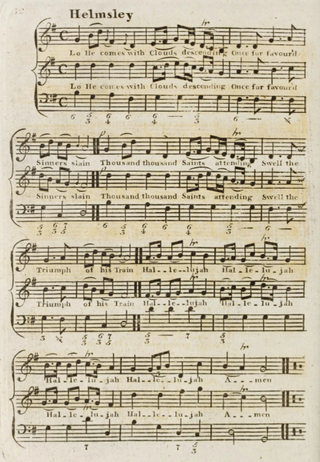A doxology is a short hymn of praises to God in various forms of Christian worship, often added to the end of canticles, psalms, and hymns. The tradition derives from a similar practice in the Jewish synagogue, where some version of the Kaddish serves to terminate each section of the service.

Shape notes are a musical notation designed to facilitate congregational and social singing. The notation became a popular teaching device in American singing schools during the 19th century. Shapes were added to the noteheads in written music to help singers find pitches within major and minor scales without the use of more complex information found in key signatures on the staff.
Decisions concerning the conduct of public worship in the Church of Scotland are entirely at the discretion of the parish minister. As a result, a wide variety of musical resources are used. However, at various times in its history, the General Assembly has commissioned volumes of psalms and hymns for use by congregations.

"Carmen Ohio" is the oldest school song still used by Ohio State University. The song was composed by freshman athlete and Men's Glee Club member Fred Cornell in 1902 or 1903. According to some accounts, he composed it on the train ride home from Ann Arbor, Michigan after Ohio State suffered an 86-0 loss to the Michigan Wolverines. The song is set to the tune of "Spanish Hymn", or "Spanish Chant". The Men's Glee Club first performed it in 1903; however, it did not gain popularity until after its publication in The Lantern on October 10, 1906. At the following Ohio State–Michigan football game on October 20, 1906, "Carmen Ohio" was published in the program. In 1915, Cornell recalled that he wrote the song in 1903 at the request of the Men's Glee Club, and other family members later stated that the train story might be an exaggeration or outright fabrication. Currently, after every home football game in Ohio Stadium, win or lose, the football team and the crowd sing the first verse of Carmen Ohio, accompanied by The Ohio State University Marching Band. It is also sung by new graduates at the end of the university's commencement ceremonies, after diplomas are distributed.
Hymns are an important part of the history and worship of the Church of Jesus Christ of Latter-day Saints.

Hymns of the Church of Jesus Christ of Latter-day Saints is the official hymnal of the Church of Jesus Christ of Latter-day Saints . Published in English in 1985, and later in many other languages, it is used throughout the LDS Church. This article refers to the English version. The book was published on the 150th anniversary of the publication of the first LDS hymnbook, compiled by Emma Smith in 1835. Previous hymnbooks used by the church include The Manchester Hymnal (1840), The Psalmody (1889), Songs of Zion (1908), Hymns (1927), and Hymns (1948).
Paraphrases are traditional forms of singing within Presbyterian churches. They are biblical paraphrases: lyrical renderings of sections of the Bible that have been set to music, in a similar fashion to metrical psalms.

The Ausbund is the oldest Anabaptist hymnal and one of the oldest Christian song books in continuous use. It is used today by North American Amish congregations.
"For the Beauty of the Earth" is a Christian hymn by Folliott S. Pierpoint (1835-1917).
"Fairest Lord Jesus", also known as "Beautiful Savior" or "Crusader's Hymn", is a Christian hymn. It was originally a hymn in German first printed in 1677, "Schönster Herr Jesu".
"How Great Thou Art" is a Christian hymn based on an original Swedish hymn entitled "O Store Gud" written in 1885 by Carl Boberg (1859–1940). The English version of the hymn and its title are a loose translation by the English missionary Stuart K. Hine from 1949. The hymn was popularised by George Beverly Shea and Cliff Barrows during Billy Graham's crusades. It was voted the British public's favourite hymn by BBC's Songs of Praise. "How Great Thou Art" was ranked second on a list of the favourite hymns of all time in a survey by Christianity Today magazine in 2001 and in a nationwide poll by Songs Of Praise in 2019.

"Thine Be the Glory, Risen Conquering Son", also titled "Thine Is the Glory", is a Christian hymn for Easter, written by the Swiss Protestant minister, Edmond Budry (1854–1932), and set to the tune of the chorus "See, the Conqu'ring hero comes" from the third section of Handel's oratorio Judas Maccabaeus. The hymn is sometimes sung at weddings or funerals.

John Fawcett was a British-born Baptist theologian, pastor and hymn writer.
"Palms of Victory", also called "Deliverance Will Come", "The Blood-washed Pilgrim", and "The Way-worn Traveler", is a Christian hymn that appears to have been written in 1836 by John B. Matthias, a Methodist Episcopal minister in New York State. This attribution is not well documented, and Matthias had no known history of songwriting, but there is no other author to whom it can be attributed.
Singing the Faith is the current authorised hymnbook of the Methodist Church of Great Britain, first published in 2011.

Ambrosius Lobwasser (1515–1585) was a German humanist and translator, born in Saxony. He served as professor of jurisprudence at the University of Königsberg from 1563 until his retirement in 1580, but is best known for his Psalter des Königlichen Propheten David, published in 1573 (Leipzig). This metrical psalter, a translation of the Genevan Psalter, became one of the standard psalm-books used by the evangelical churches of the German-speaking lands, including Switzerland. The Lobwasser psalter was widely reprinted into the 1800s.

"Lo! He comes with clouds descending" is a Christian hymn by Charles Wesley (1707–1788), based on an earlier hymn, "Lo! He cometh, countless Trumpets" by John Cennick (1718–1755). Most commonly sung at Advent, the hymn derives its theological content from the Book of Revelation relating imagery of the Day of Judgment. Considered one of the "Great Four Anglican Hymns" in the 19th century, it is most commonly sung to the tune Helmsley, first published in 1763.

Dorothy Ann Thrupp was a British psalmist, hymnwriter, and translator. Many of her psalms and hymns, which were published under various pseudonyms, were included in: Friendly Visitor ; Children's Friend ; Selection of Hymns and Poetry for the Use of Infant Schools and Nurseries ; Hymns for the Young ; and Thoughts for the Day. Thrupp was the author of Thoughts for the Day that was published in 1837, and Songs by the Way. In addition to these, her hymns were published in magazines edited by Caroline Fry. Thrupp is particularly remembered as a writer of hymns for children. "Savior, Like a Shepherd Lead us" first appeared unsigned in her collection Hymns for the Young, in 1836, with music by William B. Bradbury. Her most popular hymn was for children and it was titled A Little Ship on the Sea. Thrupp died in 1847.

Mary Dagworthy Yard James was an American hymnwriter.









